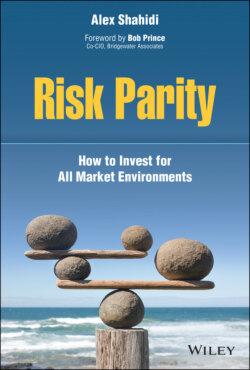Читать книгу Risk Parity - Alex Shahidi - Страница 23
RISK PARITY FRAMEWORK OVERVIEW
ОглавлениеInvestors have the opportunity to build a much more efficient allocation: one that seeks higher returns with lower risk. The breakthrough comes from expanding the menu of available investments and evaluating the asset allocation decision through a different approach. These additional asset classes are very well known; have long histories; and are supported by extremely large, public, liquid markets. They have simply been ignored because of a lack of independent analysis and a dogged herd mentality. By completely reassessing the investment options, we are taking the critical step espoused by Ray of not starting at the same point as others but commencing at the most fundamental level.
Risk parity approaches the investment problem of earning high returns while minimizing risk from a completely different vantage point from that embraced by most investment professionals. We strive for what may seem impossible when viewing the task through the conventional lens and utilizing the traditional tools. In this book, I apply a basic two‐step process to answer the following question:
How can we build a simple, passively managed portfolio that can outperform equities over the long run with less risk?
We must begin from a blank slate and without regard to conventional wisdom, which many would immediately respond with a resounding “no way!” to the question posed. In the first step, we select from the appropriate asset classes that will enable us to construct an extremely well diversified portfolio that exhibits moderate risk. This involves focusing on assets that reliably perform differently in varying economic environments. The environmental bias is the emphasis in this step since that is the main driver of asset‐class returns.
In the second step, we structure each asset class included in our portfolio to earn high returns competitive with equities over the long run. Many investors may be astounded by the ease in which we can boost the expected return of certain asset classes that are traditionally considered to be low returning. By taking these steps, we are able to build a total portfolio that can outperform stocks over the long run with much less risk. In the next chapter we will dive into these steps in detail.
Note that the objective in this book is to describe the rationale for constructing a well‐diversified balanced portfolio that is designed to serve as a reasonable allocation for a long‐term investment. The mix does not factor in any views of what the future may hold or the current valuation of any market segment. Our risk parity portfolio is an expression of an efficient neutral allocation that is designed to weather inevitable and unexpected storms.
